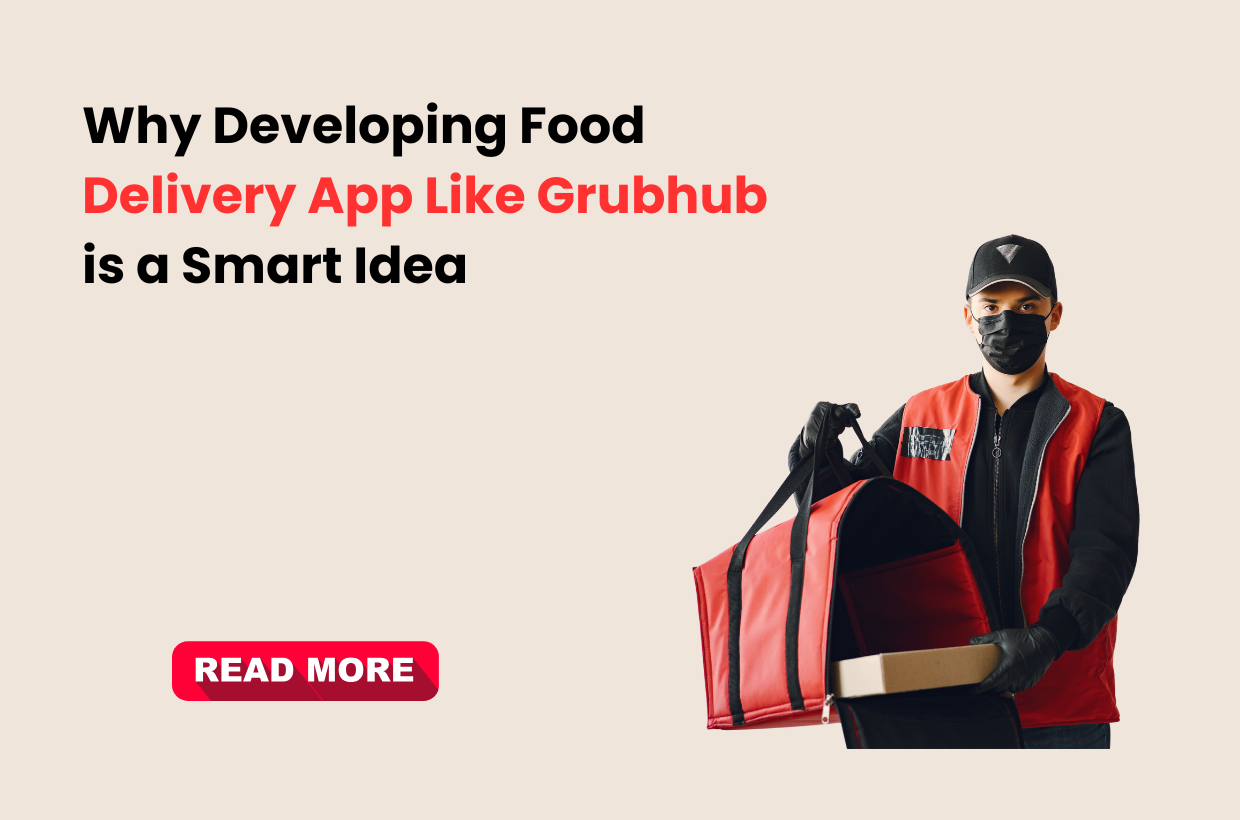Due in large part to websites like Grubhub, the online food delivery industry has seen tremendous change in the last ten years. On-demand services’ growth is a reflection of consumers’ shifting convenience preferences. With the increasing use of food delivery services, this sector presents a profitable investment potential. Strong market demand, scalability, and a variety of revenue streams are some benefits of creating a Grubhub-like food delivery app. This conversation examines the reasons why purchasing a food delivery app like Grubhub is a smart move by examining market potential, revenue sources, and critical success elements.
It is anticipated that the market for online food delivery will continue to expand quickly due to changes in customer behavior and technology developments. The rise of cloud kitchens, the dominance of big platforms, and the use of AI and IoT technology to improve delivery efficiency are some of the significant developments.
Market Potential of Food Delivery Apps
The market for food delivery apps is expanding quickly due to shifting consumer preferences and technological developments. Businesses need to stay innovative in order to meet the growing need for ease. A scalable, lucrative, and customer-focused food delivery platform can be created with the aid of an understanding of market potential.
Rapid Growth of the Food Delivery Market
The global market for online food delivery has expanded at an exponential rate in recent years. Statista predicts that the market would reach over $300 billion by 2027. The COVID-19 pandemic accelerated the spread of food delivery services, causing more individuals to rely on them for their daily meals. Even when rules relax, demand is still being driven by the efficiency and convenience of food delivery services.
Changing Consumer Preferences
Due to their busy schedules and inclination for digital solutions, customers are increasingly selecting online food delivery over traditional dining. Using mobile applications to order food is more convenient than dining out, especially for Millennials and Gen Z. The necessity for food delivery platforms is further reinforced by the desire for contactless transactions, customization choices, and real-time tracking.
Market Competitors and Room for Innovation
Although DoorDash, Uber Eats, and Grubhub dominate the industry, there is still room for new competitors that can offer unique features and better services. Niche food delivery apps that accommodate particular dietary needs, ethnic cuisines, or subscription-based meal plans might reach untapped market groups. The secret to success is improved client satisfaction, competitive pricing, and efficient food delivery app like Grubhub.
Revenue Streams of a Food Delivery App
A well-thought-out monetization strategy is necessary to generate money in the food delivery sector. In order to maintain steady profitability and long-term viability, a food delivery app can generate revenue from a variety of sources, such as commissions, delivery fees, subscription models, in-app advertising, and premium restaurant listings.
Commission-Based Model
The commission that food delivery apps charge restaurants for each order placed through the platform is one of their main sources of income. Grubhub and other apps charge restaurants a portion of the order value, which creates a consistent source of income.
Delivery Fees
Additional money can be made by charging consumers a delivery fee that is determined by factors like distance, order value, or peak hours. Some apps appeal to consumers who value speed and convenience by charging more for premium delivery services.
Subscription Plans
Numerous Food Delivery App Development Company provide membership plans that give users perks like free delivery, exclusive discounts, and first-rate customer service. For example, Grubhub+ encourages client retention and steady revenue by providing free delivery for a monthly cost.
Advertising and Promotions
Restaurants can increase their visibility on the platform by purchasing in-app advertising. In addition to helping restaurants reach a wider audience, promoted listings, banner ads, and special offers also help the app make money.
Partnerships and Corporate Orders
Another successful revenue stream is working with corporate offices to offer bulk orders and daily meal programs. In order to provide for their staff and maintain a consistent clientele, many companies choose to use food delivery app like Grubhub.
Essential Features of a Successful Food Delivery App
Apps in the fiercely competitive food delivery sector must provide more than just standard ordering features. In addition to improving the customer experience, a well-designed app should guarantee prompt and effective delivery and streamline restaurant operations. This can be accomplished by integrating a number of crucial elements that enhance usability, engagement, and general consumer and service provider happiness.
1. User-Friendly Interface
Customer retention is largely dependent on a smooth and easy-to-use user experience. Users should be able to easily explore menus, choose restaurants, and place orders with the app’s visually appealing design and intuitive navigation. Convenience is further increased by a simple checkout procedure with few steps.
2. Advanced Search and Filters
It should be easy for customers to locate the foods they want. A comprehensive search feature with criteria for restaurants, cuisines, dietary restrictions, price range, delivery time, and user reviews must be included in the app. Users can find new dining options that suit their tastes with the aid of sophisticated filtering features.
3. Real-Time Order Tracking
Customer happiness depends on delivery status transparency. Users may keep an eye on their orders from the time they are placed until they reach at their door thanks to GPS-enabled real-time tracking. Users are kept informed and involved with notifications regarding order confirmation, preparation, delivery, and projected arrival time.
4. Secure Payment Options
Customer trust depends on a smooth and safe payment mechanism. Credit and debit cards, mobile wallets, UPI payments, and cash on delivery are just a few of the payment options that the app should accept. Fraud is avoided and transaction security is guaranteed by integrating encrypted payment channels.
5. Reviews and Ratings
Customers are assisted in making well-informed judgments via a trustworthy rating and review system. Restaurants, food quality, delivery time, and overall experience should all be rated by users. In addition to improving transparency, this feature motivates eateries to uphold excellent service standards.
6. AI-Based Personalized Recommendations
Artificial intelligence may greatly increase user engagement by making restaurant and dish recommendations based on browsing history, previous orders, and preferences. Customer satisfaction and order frequency rise when consumers are encouraged to consider new options via personalized recommendations.
7. Multiple Restaurant Listings
Offering a wide variety of dining alternatives accommodates a diversity of patron tastes. The app should have a large selection of eateries, ranging from fast food chains to upscale eating venues, in order to draw in more users and increase user retention.
8. Loyalty Programs and Discounts
Brand loyalty is increased by rewarding consumers with discounts, cashback, loyalty points, and promotional offers. Restaurants and app owners can both profit from personalized offers that are based on user activity and can promote repeat business.
9. Efficient Delivery Management
Customer satisfaction depends on timely delivery. An efficient delivery system with dynamic delivery partner allocation, real-time route planning, and projected time of arrival updates should be integrated into the app. Effective logistics management guarantees that consumers receive hot, fresh meals on time and helps to minimize delays.
Challenges and Solutions in Developing a Food Delivery App
There are several obstacles to overcome while creating a food delivery app, such as making your business stand out in a crowded market and making sure that all logistics and regulations are followed. Strong collaborations, creative technologies, and strategic planning are needed to overcome these challenges. Here are a few of the main issues and workable fixes for them.
1. High Competition
The market is dominated by well-established companies in the fiercely competitive food delivery sector. New apps frequently have trouble gaining traction and drawing users.
Solution: Focus on providing distinctive features like AI-powered meal recommendations, live order customization, or environmentally friendly packaging alternatives to set your app apart from the competition. Personalized interaction, prompt assistance, and outstanding customer service are also crucial. Furthermore, employing focused marketing techniques—like influencer partnerships, referral bonuses, and hyper-local advertising—can aid in reaching the appropriate demographic and boosting user growth.
2. Logistics and Delivery Efficiency
Customer satisfaction depends on effective delivery operations. Ineffective logistics management can result in unhappy clients, delayed delivery, and increased operating expenses.
Solution: To guarantee that drivers use the quickest and most effective routes, use AI-driven route optimization. Order tracking in real time increases openness and fosters consumer confidence. Delivery times can be shortened and cost effectiveness increased by putting in place a dynamic order batching system. Expanding delivery reach without raising internal expenses can also be achieved by collaborating with outside logistics companies.
3. Retaining Customers
Customers regularly move between applications when there are several food delivery options available, which makes retention a major problem.
Solution: Implement loyalty programs that offer discounts or rebates for recurring purchases. Consistent consumption is encouraged by subscription arrangements, such as free deliveries for a monthly charge. The user experience is improved with tailored suggestions based on preferences and past orders. Boost retention with gamified rewards, limited-time offers, and partnerships with popular restaurants to keep consumers engaged and returning.
4. Restaurant Partnerships
Although establishing a robust network of restaurant partners is crucial, many restaurants are hesitant because of the high commission costs and revenue-sharing arrangements.
Solution: To ensure that the partnership benefits both parties, provide adjustable commission plans based on the size of the restaurant and the volume of orders. Restaurant owners may find your platform more appealing if you offer marketing assistance, such as social media visibility, featured listings, and in-app promos. For restaurant partners, operations can be made even simpler by connecting POS (Point of Sale) systems and guaranteeing a smooth onboarding procedure.
5. Regulatory Compliance
Food delivery and app development services must follow rules on payments, labor laws, and food safety regulations.
Solution: It is essential to follow food safety regulations by collaborating with authorized restaurant partners and making sure that the right packaging is used. Legal issues can be avoided by adhering to labor rules, which include providing delivery workers with safe working conditions and fair remuneration. User trust is increased and transactions are made smooth with secure payment channels and following financial standards. Potential legal issues can be avoided by putting automated compliance checks into place and staying current with local laws.
Conclusion
Considering the market’s explosive growth and changing consumer preferences, investing in a food delivery app like Grubhub is a wise business decision. Food delivery applications provide long-term profitability due to their scalability, multiple revenue sources, and innovative potential. In order to succeed in the cutthroat food delivery market, companies should prioritize customer experience, effective logistics, and a sound monetization plan. To optimize their investment returns, entrepreneurs wishing to enter this sector should give top priority to partnerships, technology, and customer retention tactics.
To Read More Blogs Visit: techners
















Leave a Reply